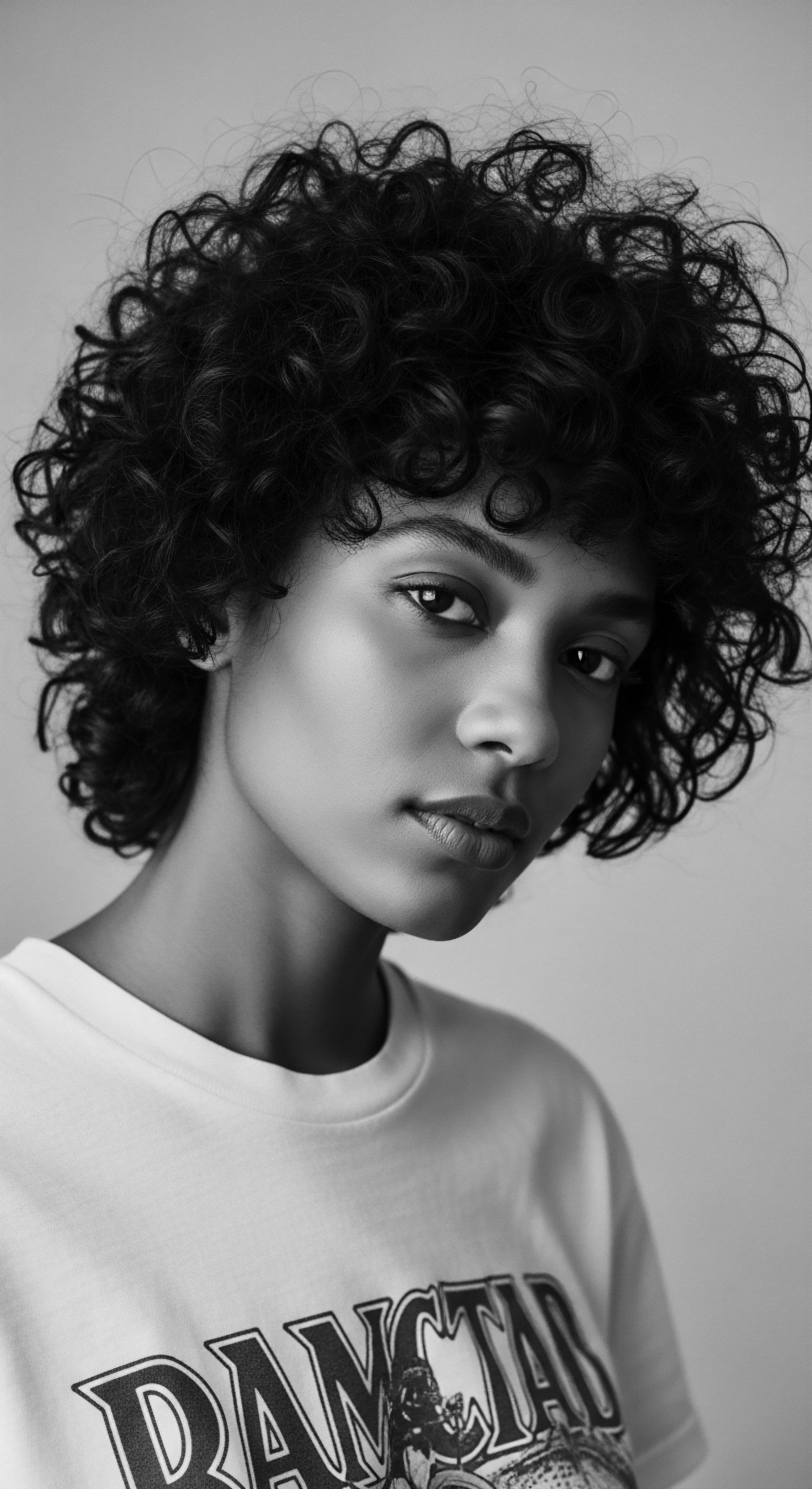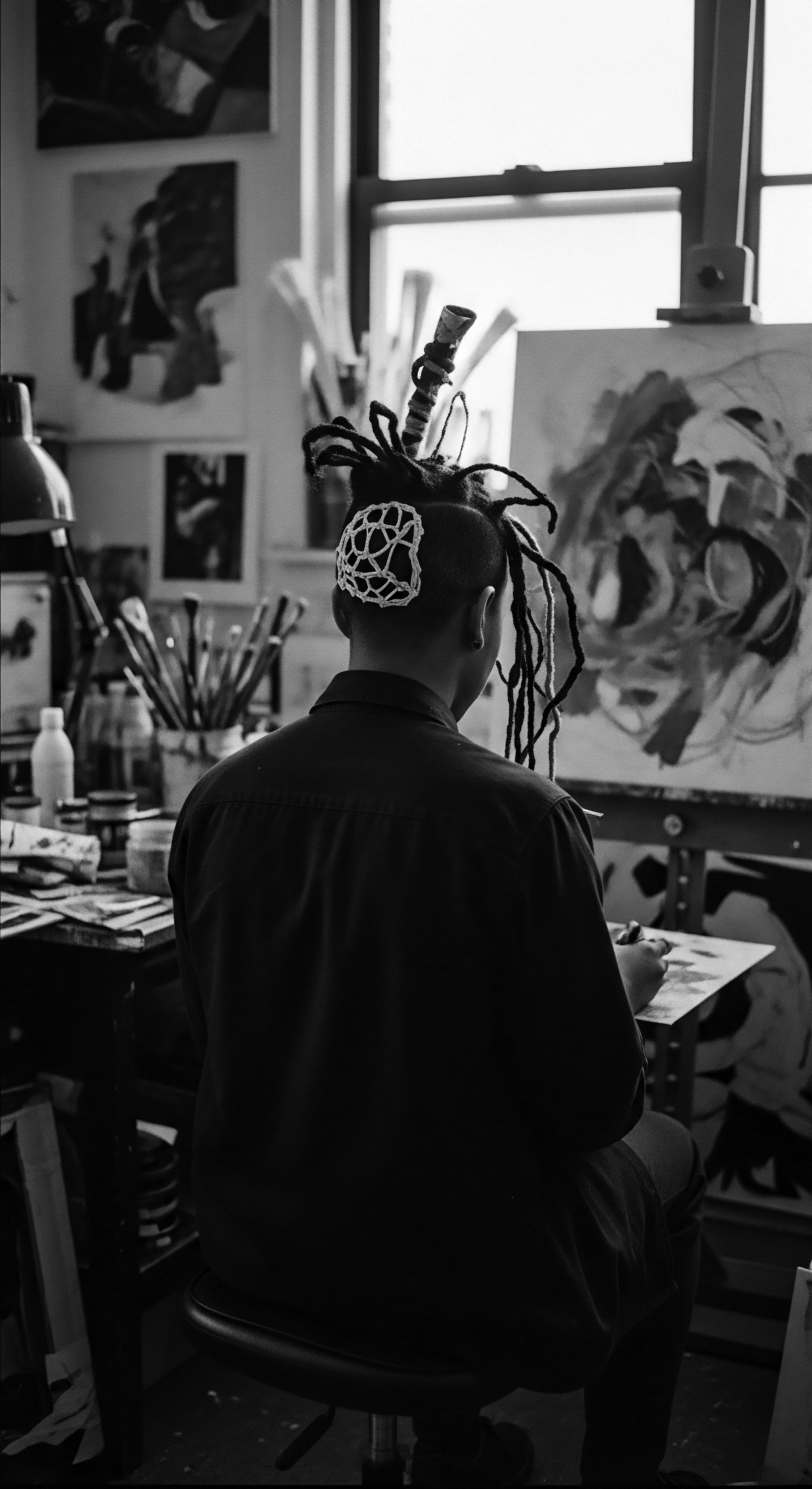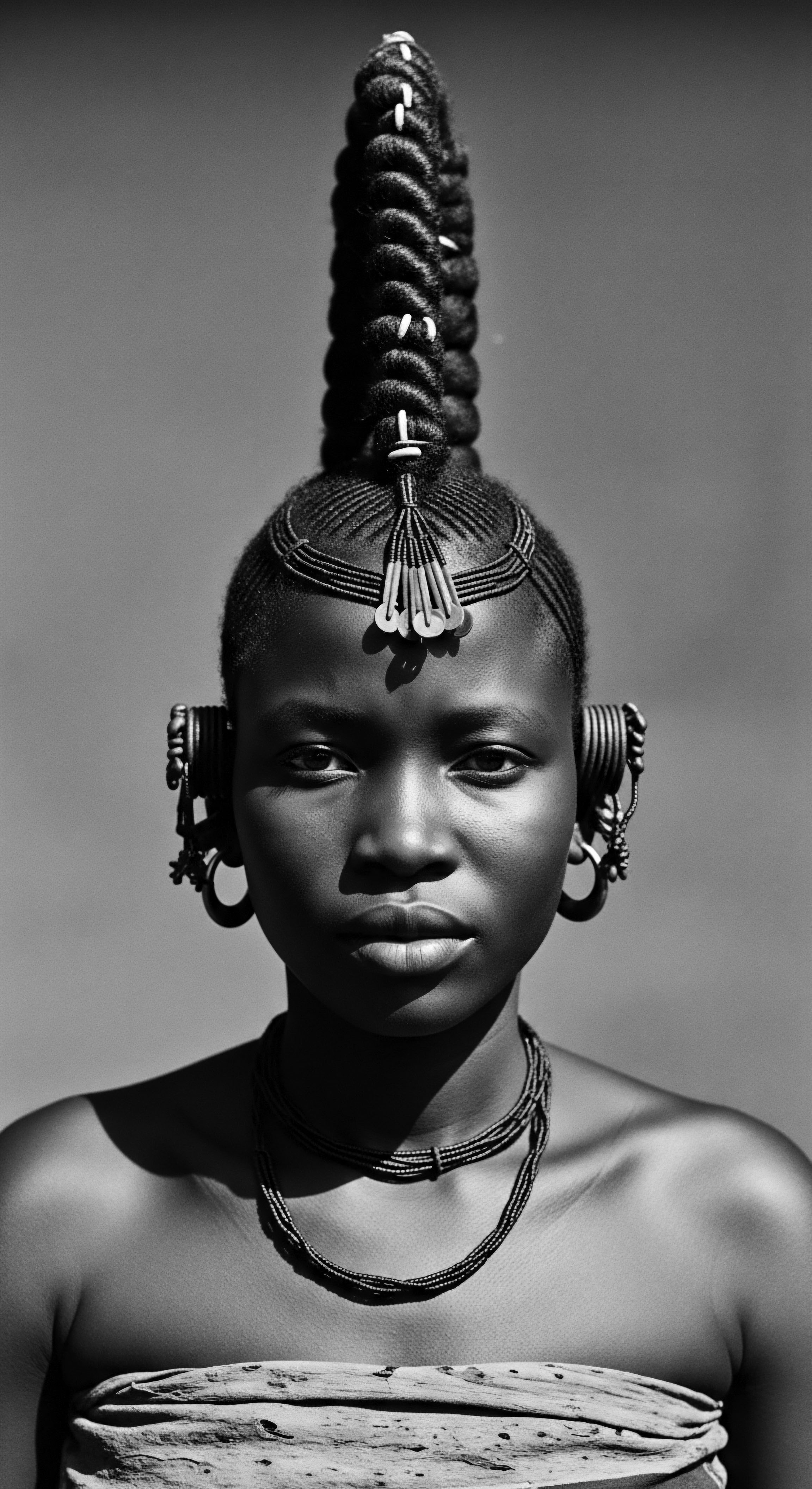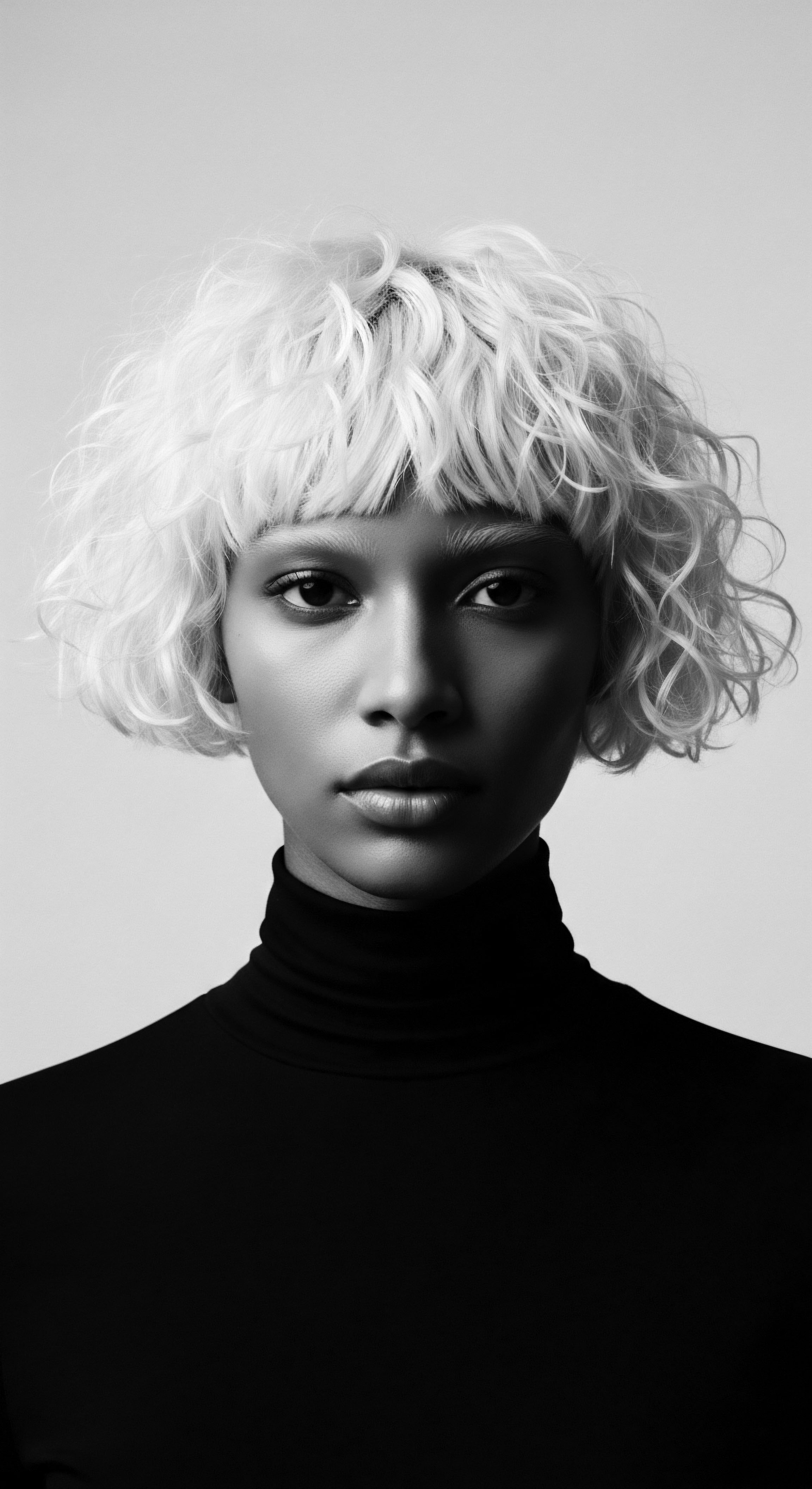
Roots
To stand at the precipice of understanding textured hair is to lean into an ancestral whisper, a reverberation across time. The question of whether science can illuminate the age-old benefits of oils on textured hair feels less like a query for a laboratory and more like a call to heritage, a recognition that the wisdom of our forebears often preceded what modern instruments could discern. For generations, before beakers and microscopes, our kin across Africa and the diaspora understood the language of their strands.
They spoke it through their hands, through botanicals gathered from the earth, through the rich, buttery textures applied with intention. This isn’t a mere cosmetic application; it is a dialogue between the spirit of a strand and the earth’s giving bounty, a conversation passed down through countless hands.

The Hair’s Intrinsic Design
Textured hair, with its unique helical twists and turns, often characterized by varying degrees of curl, coil, and zig-zag patterns, possesses a distinct morphology. Unlike straight hair, which tends to have a more uniform cylindrical shape, textured strands are often elliptical or flattened, creating points of vulnerability along their curves. This intrinsic shape means that the natural sebum produced by the scalp faces a greater challenge traveling down the hair shaft, leaving the ends particularly prone to dryness.
It is this structural reality that ancestrally led communities to seek external aids for lubrication and protection. Science, with its electron microscopes and molecular analyses, now lends a certain validation to this lived experience.
The distinctive structure of textured hair inherently presents challenges for natural hydration, making external oiling a time-honored response.
Hair is fundamentally a biopolymer, predominantly composed of cross-linked proteins known as keratins. These proteins exist in a complex bi-phase composite, a filament-matrix texture that forms the cortex, the bulk of the hair fiber. The outermost layer, the cuticle, comprises overlapping cells, forming a protective shield. In textured hair, this cortical structure is unique, featuring a bilateral distribution of orthocortex and paracortex regions.
The orthocortex, with its lower density and fewer cross-links, appears more susceptible to molecular diffusion and swelling than the denser paracortex. This leads to uneven distribution of external materials within the hair fiber.
Consider the historical example of Shea butter , a staple in West African hair care for millennia. Derived from the nut of the African shea tree (Vitellaria paradoxa), its use has been documented as far back as the 14th century, but its presence in traditional beauty practices spans thousands of years. Science now reveals that shea butter is rich in fatty acids, including oleic, stearic, linoleic, and palmitic acids, which contribute to its moisturizing qualities. It also contains unsaponifiable fractions like tocopherols (Vitamin E) and triterpenes, which possess antioxidant and anti-inflammatory properties.
These compounds create a protective barrier on the hair, limiting water loss and combating breakage, qualities deeply valued in ancestral practices for maintaining hair health in arid climates. The very act of processing shea butter, often a communal endeavor exclusively carried out by women, speaks volumes about the interwoven nature of hair care, community, and economic well-being within these heritage traditions.

Ancestral Science of Lubrication
The wisdom of ancestors was not merely anecdotal; it was an intuitive science, born of acute observation and deep connection to their environment. They understood, without modern terminology, that textured hair, being prone to dryness, benefited profoundly from lubrication. Oils and butters provided this essential element, acting as emollients and sealants. These natural substances would coat the hair shaft, smoothing the cuticle, reducing friction, and thereby mitigating mechanical damage during daily grooming activities like detangling and styling.
In West African traditions, the consistent use of oils and butters was a strategy to maintain moisture in hot, dry conditions, often combined with intricate protective styles to retain length and overall health. This was a direct response to the environment and the hair’s inherent needs.
| Ancestral Oil Shea Butter (Vitellaria paradoxa) |
| Geographic Origin West Africa |
| Key Heritage Application Moisturizing, protecting, communal ritual |
| Modern Scientific Insight Rich in fatty acids (oleic, stearic), triterpenes; provides barrier, reduces water loss, anti-inflammatory |
| Ancestral Oil Coconut Oil (Cocos nucifera) |
| Geographic Origin South India, Africa, Caribbean |
| Key Heritage Application Deep conditioning, protein retention, scalp health |
| Modern Scientific Insight Low molecular weight, linear chain; penetrates hair shaft, reduces protein loss, antibacterial, antifungal |
| Ancestral Oil Argan Oil (Argania spinosa) |
| Geographic Origin Morocco, North Africa |
| Key Heritage Application Nourishment, shine, ancestral income |
| Modern Scientific Insight Antioxidants, fatty acids (oleic, linoleic); improves elasticity, reduces frizz, UV protection |
| Ancestral Oil Castor Oil (Ricinus communis) |
| Geographic Origin Indigenous American cultures, West Africa |
| Key Heritage Application Scalp hydration, moisture retention, protective styling |
| Modern Scientific Insight Rich in ricinoleic acid; humectant, anti-inflammatory, decreases prostaglandin D2 expression in scalp |
| Ancestral Oil This table highlights how ancestral applications of oils align with contemporary scientific understandings of their molecular components and effects on textured hair fibers. |
The ancestral application of these oils was not simply about aesthetic appeal; it was a practical, informed practice for maintaining hair integrity. Science now provides the detailed molecular explanations for these observed benefits, confirming that the choices made centuries ago were indeed effective strategies for hair care, deeply rooted in a knowing connection to the earth’s provisions and the unique needs of textured strands.

Ritual
The application of oils on textured hair has always transcended mere product use; it is deeply interwoven with ritual, community, and the shaping of identity through historical shifts. These practices transformed simple substances into acts of profound cultural significance. From the ceremonial oiling before significant life events to the shared moments of hair dressing among family members, oils were central to the ‘tender thread’ that bound individuals to their heritage and to one another.

Ancestral Styling Practices and Their Oil Connection
Before the transatlantic slave trade, hair in many African societies was a canvas of identity, communicating lineage, marital status, age, and spiritual connection. The intricate styling processes, which could take hours or even days, always incorporated washing, combing, and crucially, oiling. These were not solitary acts but social opportunities, fostering bonding among family and friends. The oils served a practical purpose, making hair more pliable for braiding, twisting, and threading, while also protecting the delicate strands during these manipulations.
For instance, the Yoruba people of Nigeria, as early as the 15th century, practiced ‘Irun Kiko’ or African hair threading, a protective style involving flexible wool or cotton threads. Oils would have been essential for preparing the hair, reducing friction as sections were tied and wrapped. This blending of styling technique and natural lubrication speaks to an ancestral understanding of hair preservation.
During colonization, many African hairstyles were even banned, seen as symbols of resistance and pride. Yet, these ancestral practices, including the use of natural oils, persisted, adapted, and were fiercely protected, often becoming hidden acts of cultural preservation.
Ancestral hair rituals, particularly oiling, provided a protective foundation for complex styling, weaving together cultural expression and hair preservation.

Can Oil Texture Affect Style Resilience?
The physical properties of various oils play a significant role in their efficacy for styling and protection. Oils are composed of fatty acids, and their molecular size and structure determine how well they can penetrate the hair shaft versus sitting on the surface to seal moisture.
- Penetrating Oils ❉ Oils with smaller fatty acid molecules, such as Coconut Oil, can penetrate the hair shaft more effectively. A 1999 study noted that coconut oil reduced the cuticle’s tendency to swell, thereby lessening protein loss, which directly supports hair strength. This property makes it invaluable for reducing hygral fatigue, the damage caused by repeated water absorption and desorption, a common challenge for textured hair.
- Sealing Oils ❉ Larger molecular oils, like Jojoba Oil or Castor Oil, tend to sit more on the hair’s surface, creating a protective barrier that seals in moisture. Jojoba oil is particularly interesting as its chemical composition closely resembles human sebum, allowing it to act as an exceptional moisturizer and scalp hydrator. This characteristic makes it a valuable ally for protective styles such as braids, twists, and locs, where it hydrates without compromising the style’s integrity.
- Blended Approaches ❉ Traditional African hair care often employed a range of oils and butters, sometimes in mixtures, suggesting an intuitive understanding of combining penetrating and sealing properties for comprehensive care. The Basara tribe of Chad, for instance, uses an herb-infused oil/animal fat mixture, known as Chebe, applied weekly to their hair and braided, a practice associated with significant length retention. This blend acts both to lubricate and seal.

The Evolution of Tools and Application
The tools used in ancestral hair care, while seemingly simple, were extensions of the hand and a testament to ingenuity. Before widespread access to modern combs and brushes, wool carding tools were sometimes used to detangle. The hands, however, remained the primary tool for applying oils, massaging them into the scalp and distributing them through the strands. This manual application was integral to the ritual, ensuring even coverage and stimulating blood flow to the scalp, which promotes hair health.
The method of application, a gentle massage, enhanced the therapeutic aspects of the oils. Modern science confirms that scalp massage can boost circulation, supporting follicle health and encouraging growth. This ancestral wisdom, integrating touch and botanical ingredients, laid a foundation for contemporary hair wellness practices, reminding us that effective care involves both the tangible properties of oils and the mindful act of their application.

Relay
The journey of textured hair care, from ancient practices to modern scientific inquiry, reveals a continuum of wisdom. The ancestral benefits of oils are not merely historical footnotes; they are deeply relevant to contemporary holistic care, problem-solving, and the ongoing reclamation of hair heritage. This section delves into the sophisticated interplay between traditional knowledge and modern scientific validation, demonstrating how ancestral practices continue to inform our understanding of textured hair health.

Holistic Influences on Hair Health ❉ Connecting Ancient Wisdom to Modern Wellness
Ancestral wellness philosophies often viewed the body as an interconnected system, where hair health was not isolated from overall well-being. This perspective recognized that factors like diet, stress, and spiritual harmony directly influenced the vitality of one’s hair. The ceremonial oiling of hair was not solely a physical act; it was often a spiritual blessing, believed to protect the spirit and calm the mind. In many traditions, specific oils or herbal infusions were chosen not just for their hair properties, but for their broader therapeutic effects on the individual.
For example, in Ayurvedic traditions, prevalent in parts of South Asia and influencing diaspora communities globally, hair oiling is a meditative act. The Sanskrit word for oil, “sneha,” also means “to love,” underscoring the practice as an act of self-care and affection. Oils such as Brahmi or Bhringraj, traditionally used for hair growth and strengthening, are also noted for their calming effects on the mind, reducing stress and improving sleep quality, which indirectly contribute to healthier hair. This integrated view of hair health as a reflection of internal balance is a profound contribution from ancestral wisdom.

Can Science Replicate Ancestral Knowledge?
Modern science, through its investigative tools, has begun to unravel the complex mechanisms behind these time-honored practices. While ancient cultures relied on observation and inherited wisdom, current research can pinpoint the molecular interactions that confer specific benefits.
A study published in the journal Cosmetics by Brazilian researchers in late 2024 offers compelling insights into the penetration of vegetable oils into textured hair fibers. Using advanced Matrix-Assisted Laser Desorption Ionization Time-of-Flight Mass Spectrometry (MALDI–TOF MS), combined with mechanical testing, they examined the effects of coconut, avocado, and argan oils on both virgin and bleached textured hair. The study revealed that while these oils did indeed penetrate the cortical regions of bleached textured hair, with Argan Oil showing the highest intensity of presence, their effects on hair strength (measured by Young’s modulus or break stress) were limited and varied based on hair type and bleaching.
This suggests that while oils provide clear benefits like moisture retention and cuticle smoothing, their role in deeply modifying the mechanical properties of textured hair may be more nuanced than previously assumed, particularly in damaged hair. This scientific inquiry allows for a deeper, rather than simplistic, appreciation of how oils interact with the intricate structure of textured hair.

Understanding Oil Penetration and Hair Structure
The structural differences between hair types are paramount. Textured hair’s unique morphology, with its waves and twists, creates areas of varying density within the fiber. This leads to distinct diffusion zones where molecules can penetrate more or less readily.
For instance, the orthocortex, a region within the cortex, is more open to diffusion due to lower matrix density, while the paracortex presents greater resistance. This irregular distribution of oils within textured hair contributes to the varied efficacy of treatments.
The ability of certain oils to reduce protein loss is a key scientific finding. Coconut Oil, with its low molecular weight and straight linear chain, is particularly adept at penetrating the hair shaft, thereby reducing protein loss from within. This is crucial for textured hair, which is inherently more prone to breakage due to its structural characteristics. By filling the gaps in the cuticle layer, oils aid in strengthening strands and reducing protein loss during washing and detangling, a common source of damage.

The Nighttime Sanctuary ❉ Bonnet Wisdom and Oil Application
Nighttime care for textured hair, often involving bonnets, scarves, or silk pillowcases, is another practice rooted in ancestral wisdom that finds contemporary scientific backing. These coverings protect hair from friction against rough fabrics, which can lead to breakage and moisture loss. Oiling hair before sleep, a common ancestral ritual, works in tandem with protective head coverings. It allows oils to slowly absorb and seal in moisture, preparing the hair for the stresses of the next day.
Consider the practice in some Horn of Africa communities, where clarified butter or ghee was used to treat hair for thousands of years, sometimes applied as a block on the head to melt slowly under the sun, simultaneously nourishing hair and cooling the scalp. While modern bonnets offer a different application, the intent of sustained, deep nourishment and protection remains unchanged. The modern scientific understanding of hair’s susceptibility to mechanical damage, particularly in textured hair, validates the protective efficacy of these ancestral nighttime rituals.
- Hydration Retention ❉ Oils, when applied to hair, form a lipid layer that slows down the evaporation of water, helping strands remain hydrated longer. This is especially important for textured hair, which struggles to retain moisture due to its coiled structure.
- Reduced Friction ❉ The presence of oil on the hair surface provides increased slip, significantly reducing friction during combing, styling, or even tossing and turning during sleep. This minimizes mechanical damage and breakage.
- Scalp Wellness ❉ Many traditional oils possess antimicrobial and antifungal properties. For instance, Neem Oil is well-regarded for combating scalp infections and dandruff, promoting a healthy environment for hair growth.
The confluence of ancestral practice and modern scientific analysis paints a richer, more complete picture of the benefits of oils on textured hair. It demonstrates that the intuition of past generations, guided by an intimate knowledge of their bodies and environments, laid the groundwork for understandings that science now seeks to articulate in molecular terms.

Reflection
To gaze upon textured hair, particularly in its deep heritage, is to witness a living archive. It holds stories, resilience, and wisdom passed through the currents of time. The exploration of oils, from the touch of ancestral hands to the precision of modern spectrometry, illuminates a timeless truth ❉ our forebears instinctively understood the needs of their coils and kinks. They sought solutions within the earth, crafting rituals that transcended mere grooming, becoming acts of cultural continuity and personal affirmation.
The enduring presence of oils in textured hair care, their journey from the communal pot to the scientific laboratory, reminds us that the quest for knowledge is cyclical. It circles back to the source, to the fundamental wisdom held within each strand, affirming that the soul of a strand is indeed a profound meditation on heritage and its care, a vibrant, breathing testament to enduring beauty.

References
- Adegbulu, A. (2020). Shea butter as skin, scalp, and hair moisturizer in Nigerians. Sci-Hub .
- Ajmera, A. R. (2022). The Way of the Goddess ❉ Daily Rituals to Awaken Your Inner Warrior and Discover Your True Self .
- Draelos, Z. D. (2025). Historical Perspectives on Hair Care and Common Styling Practices in Black Women. Journal of Drugs in Dermatology .
- Essel, S. (2021). Historical Roots of Makai Hairstyle of Elmina People of Ghana. International Journal of Arts and Social Science .
- Ghasemi, M. R. & Mirzajani, F. (2019). Adsorption of Natural Oil Spills Using Human Hair As Sorbent. Asian Journal of Applied Science and Technology, 3(3), 184-188.
- Keis, K. et al. (1999). Effect of oil treatment on hair protein to combat combing damage. Journal of Cosmetic Science, 50(5), 327-336.
- Livara Natural Organics. (2024). Which Oils Are The Best For Afro-Textured Hair?
- Miele Organics. (2025). 10 Protective Styles for Natural Hair.
- MDPI. (2024). Penetration of Vegetable Oils into Textured Hair Fibers ❉ Integrating Molecular Matrix Assisted Laser Desorption Ioni-Zation Time-of-Flight Mass Spectroscopy (MALDI TOF/TOF MS) Analysis with Mechanical Measurements. Cosmetics .
- Newsweek. (2022). Everything You Need To Know About The Ancient Art Of Hair Oiling.
- Pattanaik, R. (2021). Ancient African Hair Growth Secrets For Healthy Hair. Sellox Blog .
- Sahani, S. Yadav, K. D. & Bind, S. (2020). Ayurvedic kesh tail (hair oil) asserted and promoted. World Journal of Pharmaceutical Research .
- Shankara India. (2024). 10 Surprising Almond Oil Benefits for Skin & Hair.
- Typology. (2023). What are the active molecules in shea butter?
- UAL Research Online. (2021). African hair ❉ exploring the protective effects of natural oils and silicones.
- Vydoorya. (2024). Kerala’s Heritage in a Bottle ❉ The Benefits of Traditional Hair Oils.
- Wilson, I. (2022). “Hair oiling has been in common use for those with afro-textured hair for a long time.” Newsweek .
- Zipe It. (2024). The Benefits of Herbal Hair Oil ❉ Nature’s Secret to Luscious Locks.
